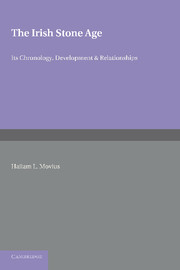Book contents
- Frontmatter
- Dedication
- Contents
- ILLUSTRATIONS
- FOREWORD
- PREFACE
- INTRODUCTION
- Part One THE CHRONOLOGY OF THE LATE-GLACIAL AND EARLY POST-GLACIAL PERIODS IN NORTHERN AND WESTERN EUROPE
- Part Two THE STONE AGE CULTURES OF IRELAND
- Appendices I-VI
- APPENDIX I The Raised Beach of the Third Interglacial Period
- APPENDIX II Deposits of the Interstadial Period between the Old and the New Drift Glaciations (W1/W2) in England and Scotland
- APPENDIX III The New Drift Glaciation
- APPENDIX IV The Recession of the Last Ice-Sheets
- APPENDIX V Deposits of the Late-Glacial Sea
- APPENDIX VI Submerged Forests and Raised Beaches in Britain and Ireland
- REFERENCES CITED IN THE TEXT
- CLASSIFIED LIST OF REFERENCES TO CAVE RESEARCH AND STONE AGE ARCHAEOLOGY IN IRELAND
- ADDENDUM
- INDEX
APPENDIX V - Deposits of the Late-Glacial Sea
from Appendices I-VI
Published online by Cambridge University Press: 05 June 2016
- Frontmatter
- Dedication
- Contents
- ILLUSTRATIONS
- FOREWORD
- PREFACE
- INTRODUCTION
- Part One THE CHRONOLOGY OF THE LATE-GLACIAL AND EARLY POST-GLACIAL PERIODS IN NORTHERN AND WESTERN EUROPE
- Part Two THE STONE AGE CULTURES OF IRELAND
- Appendices I-VI
- APPENDIX I The Raised Beach of the Third Interglacial Period
- APPENDIX II Deposits of the Interstadial Period between the Old and the New Drift Glaciations (W1/W2) in England and Scotland
- APPENDIX III The New Drift Glaciation
- APPENDIX IV The Recession of the Last Ice-Sheets
- APPENDIX V Deposits of the Late-Glacial Sea
- APPENDIX VI Submerged Forests and Raised Beaches in Britain and Ireland
- REFERENCES CITED IN THE TEXT
- CLASSIFIED LIST OF REFERENCES TO CAVE RESEARCH AND STONE AGE ARCHAEOLOGY IN IRELAND
- ADDENDUM
- INDEX
Summary
Deposits of the Late-Glacial Sea are better developed in Scotland than elsewhere in Britain and Ireland. In South-Western Ayrshire—in the Rhinns of Galloway and near Kircudbright—and on the east coast of St Abbs Head, 50-foot raised beaches have been reported, while in the former region between Girvan and Ballantrae, and at Dunbar, Haddingtonshire, this feature occurs at 75 feet above O.D. (Kendall and Bailey, 1907, p. 31; Charlesworth, 1926, pp. 21—2; B.R.G. [j], p. 92). This marks the southern limit of this Late-Glacial phenomenon in Northern Britain, although traces of it exist on the Northumbrian and Durham coasts (Woolacott, 1921, p. 68). In the region of the other great centre of the last ice—North-West Ireland—the extent of these marine platforms is very little known except in the northern part of County Donegal. Brooks (1917, p. 332) records a shelf at 70 feet above present water-level on Horn Head, and high-level beaches exist at 50, 75 and 100 feet in Inishowen (Praeger, 1895, pp. 282—3). In North Wales a Late-Glacial raised beach at + 50 feet O.D. has been reported (Matley, 1936), and on the coast of County Wicklow in Ireland a Late-Glacial 50-foot marine platform is likewise present (Farrington, 1.934, P- 204)- In both cases contemporaneity with the recession of the local ice has been demonstrated. It seems probable that the Heatherslade raised beach of the Gower Peninsula in Southern Wales (George, 1932, p. 316) also belongs to this period. In North-East Ireland the effects of marine erosion, following the recession of the last ice in this region, have been observed at an approximate level of 50 feet O.D. at a few localities on the County Antrim coast. Thus at Red Bay there are caves at this height near the town of Waterfoot (M.G.S. Ireland, 1876, p. 36), and a wave-cut platform, a cave, as well as a 50-foot terrace, were found on the north side of Cushendun Bay near the 50-foot level (Richardson, 1940, p. 13). The 100-foot beach in Southern Scotland is extensively developed on the North Ayrshire coast (M.G.S. Scotland, 1930, pp. 342-3) and west of Glasgow (M.G.S. Scotland, 1925, p. 231).
- Type
- Chapter
- Information
- The Irish Stone AgeIts Chronology, Development and Relationships, pp. 284 - 287Publisher: Cambridge University PressPrint publication year: 2013



